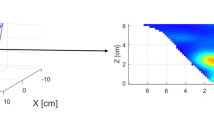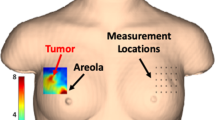Abstract
Purpose
Breast cancer (BC) patients who achieve a favorable residual cancer burden (RCB) after neoadjuvant chemotherapy (NACT) have an improved recurrence-free survival. Those who have an unfavorable RCB will have gone through months of ineffective chemotherapy. No ideal method exists to predict a favorable RCB early during NACT. Diffuse optical tomography (DOT) is a novel imaging modality that uses near-infrared light to assess hemoglobin concentrations within breast tumors. We hypothesized that the 2-week percent change in DOT-measured hemoglobin concentrations would associate with RCB.
Methods
We conducted an observational study of 40 women with stage II–IIIC BC who received standard NACT. DOT imaging was performed at baseline and 2 weeks after treatment initiation. We evaluated the associations between the RCB index (continuous measure), class (categorical 0, I, II, III), and response (RCB class 0/I = favorable, RCB class II/III = unfavorable) with changes in DOT-measured hemoglobin concentrations.
Results
The RCB index correlated significantly with the 2-week percent change in oxyhemoglobin [HbO2] (r = 0.5, p = 0.003), deoxyhemoglobin [Hb] (r = 0.37, p = 0.03), and total hemoglobin concentrations [HbT] (r = 0.5, p = 0.003). The RCB class and response significantly associated with the 2-week percent change in [HbO2] (p ≤ 0.01) and [HbT] (p ≤ 0.02). [HbT] 2-week percent change had sensitivity, specificity, positive, and negative predictive values for a favorable RCB response of 86.7, 68.4, 68.4, and 86.7%, respectively.
Conclusion
The 2-week percent change in DOT-measured hemoglobin concentrations was associated with the RCB index, class, and response. DOT may help guide NACT for women with BC.



Similar content being viewed by others
Abbreviations
- A:
-
Doxorubicin
- BC:
-
Breast cancer
- BMI:
-
Body mass index
- C:
-
Cyclophosphamide
- CT:
-
Computerized tomography
- DOT:
-
Diffuse optical tomography
- [Hb]:
-
Deoxyhemoglobin concentration
- [HbO2]:
-
Oxyhemoglobin concentration
- [HbT]:
-
Total hemoglobin concentration
- HER2:
-
Human epidermal growth factor receptor 2
- HR:
-
Hormone receptor
- MRI:
-
Magnetic resonance imaging
- NACT:
-
Neoadjuvant chemotherapy
- nm:
-
Nanometer
- NPV:
-
Negative predictive value
- pCR:
-
Pathologic complete response
- PET:
-
Position emission tomography
- PPV:
-
Positive predictive value
- RCB:
-
Residual cancer burden
- ROI:
-
Region of interest
- SD:
-
Standard deviation
- T:
-
Paclitaxel
- US:
-
Ultrasound
- WF:
-
Water fraction
References
Fisher B, Bryant J, Wolmark N, Mamounas E, Brown A, Fisher ER, Wickerham DL, Begovic M, DeCillis A, Robidoux A et al (1998) Effect of preoperative chemotherapy on the outcome of women with operable breast cancer. J Clin Oncol 16(8):2672–2685
Scholl SM, Fourquet A, Asselain B, Pierga JY, Vilcoq JR, Durand JC, Dorval T, Palangie T, Jouve M, Beuzeboc P et al (1994) Neoadjuvant versus adjuvant chemotherapy in premenopausal patients with tumours considered too large for breast conserving surgery: preliminary results of a randomised trial: S6. Eur J Cancer 30A(5):645–652
Makris A, Powles TJ, Ashley SE, Chang J, Hickish T, Tidy VA, Nash AG, Ford HT (1998) A reduction in the requirements for mastectomy in a randomized trial of neoadjuvant chemoendocrine therapy in primary breast cancer. Ann Oncol 9(11):1179–1184
Mauriac L, MacGrogan G, Avril A, Durand M, Floquet A, Debled M, Dilhuydy JM, Bonichon F (1999) Neoadjuvant chemotherapy for operable breast carcinoma larger than 3 cm: a unicentre randomized trial with a 124-month median follow-up. Institut Bergonie Bordeaux Groupe Sein (IBBGS). Ann Oncol 10(1):47–52
Symmans WF, Peintinger F, Hatzis C, Rajan R, Kuerer H, Valero V, Assad L, Poniecka A, Hennessy B, Green M et al (2007) Measurement of residual breast cancer burden to predict survival after neoadjuvant chemotherapy. J Clin Oncol 25(28):4414–4422
Brix G, Lechel U, Glatting G, Ziegler SI, Munzing W, Muller SP, Beyer T (2005) Radiation exposure of patients undergoing whole-body dual-modality 18F-FDG PET/CT examinations. J Nucl Med 46(4):608–613
Buck AK, Herrmann K, Stargardt T, Dechow T, Krause BJ, Schreyogg J (2010) Economic evaluation of PET and PET/CT in oncology: evidence and methodologic approaches. J Nucl Med Technol 38(1):6–17
Chagpar AB, Middleton LP, Sahin AA, Dempsey P, Buzdar AU, Mirza AN, Ames FC, Babiera GV, Feig BW, Hunt KK et al (2006) Accuracy of physical examination, ultrasonography, and mammography in predicting residual pathologic tumor size in patients treated with neoadjuvant chemotherapy. Ann Surg 243(2):257–264
Schott AF, Roubidoux MA, Helvie MA, Hayes DF, Kleer CG, Newman LA, Pierce LJ, Griffith KA, Murray S, Hunt KA et al (2005) Clinical and radiologic assessments to predict breast cancer pathologic complete response to neoadjuvant chemotherapy. Breast Cancer Res Treat 92(3):231–238
Zhu Q, Tannenbaum S, Hegde P, Kane M, Xu C, Kurtzman SH (2008) Noninvasive monitoring of breast cancer during neoadjuvant chemotherapy using optical tomography with ultrasound localization. Neoplasia 10(10):1028–1040
Flexman ML, Hernandez SL, Huang J, Johung TJ, Kim HK, Lee J, Vlachos F, Yamashiro DJ, Kandel J, Hielscher AH (2010) Early detection of tumor vascular response to anti-angiogenic drugs with optical tomography. Optical Society of America (OSA) topical meeting, Miami, Florida, 13 April 2010
Cerussi A, Hsiang D, Shah N, Mehta R, Durkin A, Butler J, Tromberg BJ (2007) Predicting response to breast cancer neoadjuvant chemotherapy using diffuse optical spectroscopy. Proc Natl Acad Sci USA 104(10):4014–4019
Soliman H, Gunasekara A, Rycroft M, Zubovits J, Dent R, Spayne J, Yaffe MJ, Czarnota GJ (2010) Functional imaging using diffuse optical spectroscopy of neoadjuvant chemotherapy response in women with locally advanced breast cancer. Clin Cancer Res 16(9):2605–2614
Zhou D, Cheng SQ, Ji HF, Wang JS, Xu HT, Zhang GQ, Pang D (2010) Evaluation of protein pigment epithelium-derived factor (PEDF) and microvessel density (MVD) as prognostic indicators in breast cancer. J Cancer Res Clin Oncol 136:1719–1727
Flexman ML, Khalil MA, Al Abdi R, Kim HK, Fong CJ, Desperito E, Hershman DL, Barbour RL, Hielscher AH (2011) Digital optical tomography system for dynamic breast imaging. J Biomed Opt 16(7):076014
Zhu Q, Huang M, Chen N, Zarfos K, Jagjivan B, Kane M, Hedge P, Kurtzman SH (2003) Ultrasound-guided optical tomographic imaging of malignant and benign breast lesions: initial clinical results of 19 cases. Neoplasia 5(5):379–388
Zhu Q, Ricci A Jr, Hegde P, Kane M, Cronin E, Merkulov A, Xu Y, Tavakoli B, Tannenbaum S (2016) Assessment of functional differences in malignant and benign breast lesions and improvement of diagnostic accuracy by using US-guided diffuse optical tomography in conjunction with conventional US. Radiology. doi:10.1148/radiol.2016151097
Ueda S, Nakamiya N, Matsuura K, Shigekawa T, Sano H, Hirokawa E, Shimada H, Suzuki H, Oda M, Yamashita Y et al (2013) Optical imaging of tumor vascularity associated with proliferation and glucose metabolism in early breast cancer: clinical application of total hemoglobin measurements in the breast. BMC Cancer 13:514
Chung SH, Feldman MD, Martinez D, Kim H, Putt ME, Busch DR, Tchou J, Czerniecki BJ, Schnall MD, Rosen MA et al (2015) Macroscopic optical physiological parameters correlate with microscopic proliferation and vessel area breast cancer signatures. Breast Cancer Res 17:72
Kim MJ, Su MY, Yu HJ, Chen JH, Kim EK, Moon HJ, Choi JS (2016) US-localized diffuse optical tomography in breast cancer: comparison with pharmacokinetic parameters of DCE-MRI and with pathologic biomarkers. BMC Cancer 16(1):50
Xiao M, Jiang Y, Zhu Q, You S, Li J, Wang H, Lai X, Zhang J, Liu H, Zhang J (2015) Diffuse optical tomography of breast carcinoma: can tumor total hemoglobin concentration be considered as a new promising prognostic parameter of breast carcinoma? Acad Radiol 22(4):439–446
Ueda S, Yoshizawa N, Shigekawa T, Takeuchi H, Ogura H, Osaki A, Saeki T, Ueda Y, Yamane T, Kuji I et al (2016) Near-infrared diffuse optical imaging for early prediction of breast cancer response to neoadjuvant chemotherapy: a comparative study using FDG-PET/CT. J Nucl Med 57(8):1189–1195
Jiang S, Pogue BW, Carpenter CM, Poplack SP, Wells WA, Kogel CA, Forero JA, Muffly LS, Schwartz GN, Paulsen KD et al (2009) Evaluation of breast tumor response to neoadjuvant chemotherapy with tomographic diffuse optical spectroscopy: case studies of tumor region-of-interest changes. Radiology 252(2):551–560
Jiang S, Pogue BW, Kaufman PA, Gui J, Jermyn M, Frazee TE, Poplack SP, DiFlorio-Alexander R, Wells WA, Paulsen KD (2014) Predicting breast tumor response to neoadjuvant chemotherapy with diffuse optical spectroscopic tomography prior to treatment. Clin Cancer Res 20(23):6006–6015
Ueda S, Roblyer D, Cerussi A, Durkin A, Leproux A, Santoro Y, Xu S, O’Sullivan TD, Hsiang D, Mehta R et al (2012) Baseline tumor oxygen saturation correlates with a pathologic complete response in breast cancer patients undergoing neoadjuvant chemotherapy. Cancer Res 72(17):4318–4328
Xu C, Vavadi H, Merkulov A, Li H, Erfanzadeh M, Mostafa A, Gong Y, Salehi H, Tannenbaum S, Zhu Q (2016) Ultrasound-guided diffuse optical tomography for predicting and monitoring neoadjuvant chemotherapy of breast cancers: recent progress. Ultrason Imaging 38(1):5–18
Zhu Q, DeFusco PA, Ricci A Jr, Cronin EB, Hegde PU, Kane M, Tavakoli B, Xu Y, Hart J, Tannenbaum SH (2013) Breast cancer: assessing response to neoadjuvant chemotherapy by using US-guided near-infrared tomography. Radiology 266(2):433–442
Ogston KN, Miller ID, Payne S, Hutcheon AW, Sarkar TK, Smith I, Schofield A, Heys SD (2003) A new histological grading system to assess response of breast cancers to primary chemotherapy: prognostic significance and survival. Breast 12(5):320–327
Bossuyt V, Provenzano E, Symmans WF, Boughey JC, Coles C, Curigliano G, Dixon JM, Esserman LJ, Fastner G, Kuehn T et al (2015) Recommendations for standardized pathological characterization of residual disease for neoadjuvant clinical trials of breast cancer by the BIG-NABCG collaboration. Ann Oncol 26(7):1280–1291
Loo CE, Straver ME, Rodenhuis S, Muller SH, Wesseling J, Vrancken Peeters MJ, Gilhuijs KG (2011) Magnetic resonance imaging response monitoring of breast cancer during neoadjuvant chemotherapy: relevance of breast cancer subtype. J Clin Oncol 29(6):660–666
Funding
This study was funded by Grants from the Komen Foundation for the Cure Post Doctoral Fellowship Research Grant to EAL, National Science Foundation Integrative Graduate Education and Research Traineeship program on Optical Techniques for Actuation, Sensing, and Imaging of Biological Systems at Columbia University to JEG, and the Natural Sciences and Engineering Research Council of Canada (NSERC) to MF. This publication was also supported by the National Center for Advancing Translational Sciences, National Institutes of Health, through Grant No. KL2 TR000081 to KK. The content is solely the responsibility of the authors and does not necessarily represent the official views of the National Institutes of Health. This research was also supported in part by the Witten Family Fund.
Author information
Authors and Affiliations
Corresponding author
Ethics declarations
Conflict of interest
All authors declare that they have no conflict of interest.
Ethical approval
All procedures performed in studies involving human participants were in accordance with the ethical standards of the institutional and/or national research committee and with the 1964 Helsinki declaration and its later amendments or comparable ethical standards.
Informed consent
:Informed consent was obtained from all individual participants included in the study.
Additional information
Emerson A. Lim, Jacqueline E. Gunther, Andreas Hielscher and Dawn L. Hershman have contributed equally to this work.
Electronic supplementary material
Below is the link to the electronic supplementary material.
Rights and permissions
About this article
Cite this article
Lim, E.A., Gunther, J.E., Kim, H.K. et al. Diffuse optical tomography changes correlate with residual cancer burden after neoadjuvant chemotherapy in breast cancer patients. Breast Cancer Res Treat 162, 533–540 (2017). https://doi.org/10.1007/s10549-017-4150-7
Received:
Accepted:
Published:
Issue Date:
DOI: https://doi.org/10.1007/s10549-017-4150-7




